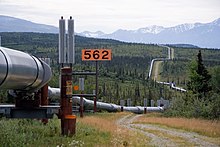
Operators of the Trans-Alaska Pipeline System, shut Jan. 8 while a leak is repaired, can’t say when the pipeline that carries 15 percent of U.S. crude oil output will be flowing again.
The shutdown has forced oil companies including BP Plc to suspend 95 percent of production from the North Slope area. The system, an 800-mile network crossing the northernmost U.S. state, was closed at about 8:50 a.m. Alaska time Jan. 8, operator Alyeska Pipeline Service Co. said in a statement. The line was still closed as of 2:21 p.m. local time yesterday with no estimate of when it would be returned to service, Michelle Egan, a spokeswoman for Alyeska, said in a telephone interview.
Oil futures in New York jumped as much as 2.2 percent to $89.98 a barrel, advancing for the first time in three days. The leak, which has been contained, was thought to be located in an underground section of piping encased in concrete at Pump Station 1, Alyeska said in its statement. Producers have been limited to 5 percent of normal output, Egan said.
“The shutdown is being factored into prices,” Ben Westmore, a minerals and energy economist at National Australia Bank Ltd. in Melbourne. “People are a little more concerned with supply constraints than they were six months ago.”
The shutdown is a further setback for BP, whose well blowout in the Gulf of Mexico in April led to the biggest offshore oil spill in U.S. history. Crude prices rose 21 percent in the second half of last year, and reached a 27-month high of $92.58 on Jan. 3 on speculation the U.S. economic recovery will boost fuel demand in the world’s biggest oil-consuming country.
Oil May Climb
Oil may climb further if the pipeline problem isn’t fixed, said Gavin Wendt, founding director at MineLife Pty in Sydney.
If there is no resolution by today, “we may see prices heading towards $90 a barrel or higher,” Wendt said. “The market is very susceptible to supply-side problems.”
The pipeline system transported an average 642,261 barrels a day last month, according to Alyeska’s website. The network starts in Prudhoe Bay on the North Slope and runs to Valdez, the northernmost ice-free port in North America. Since it began operating in 1977, Alyeska has shipped more than 16 billion barrels of oil, according to the website.
Tankers were being loaded with reserve inventories at Valdez yesterday, Egan said. She couldn’t estimate the amount of oil that remained in reserve.
“Engineers are assessing the situation and developing a plan to safely restart the pipeline,” Alyeska said. One possible plan would be to design a pipe bypass for the system, Egan said. “We are looking at a variety of options.”
Oil Recovery
There were no injuries and no “apparent impacts to the environment,” the company said. Federal and state staff are helping with the response and crews began recovering oil about seven hours after the shutdown, Alyeska said. About 90 of the oil, some nine or 10 barrels, that leaked into a booster pump building had been recovered yesterday, Egan said.
Toby Odone, a London-based spokesman for BP, said it’s up to Alyeska to provide updates, and declined to comment further. Alyeska is owned by BP, ConocoPhillips, Exxon Mobil Corp., Chevron Corp. and Koch Industries Inc., according to statements on its website.
BP is cutting crude output on Alaska’s North Slope by 95 percent, Steve Rinehart, a company spokesman, said by phone from Anchorage. BP’s North Slope production is about 410,000 barrels a day.
Prudhoe Bay and other Alaskan fields were BP’s largest source of crude in the Western Hemisphere in 2009 after the Gulf of Mexico, according to a public filing. Alaskan fields provided one in every 14 barrels of oil BP pumped worldwide that year. The company operates or holds stakes in 20 other fields on Alaska’s North Slope, as well as four pipelines.
Largest Field
BP owns 26 percent of Prudhoe Bay and neighboring fields in Alaska with Exxon, ConocoPhillips and Chevron. The Prudhoe Bay deposit, the largest field in the U.S., came online in 1977 and can produce about 400,000 barrels a day.
The Alaskan pipeline system was also shut last May after a leak, according to a company statement at the time. In March 2006, the Trans-Alaska system spilled 6,400 barrels in a leak caused by corrosion on a pipe wall.
“We have had significant production reduction before for various reasons, including bad weather,” said BP’s Rinehart. “It’s not uncommon.” The company can’t tell how long the shutdown will last, he said.
ConocoPhillips has prorated its production to 5 percent, Natalie Lowman, a ConocoPhillips spokeswoman in Anchorage, said yesterday in a telephone interview.
BP Stock
BP shares have gained about 60 percent since June after the company agreed to set up an escrow account to pay for the cleanup and economic losses from the Macondo well blowout. The April 20 explosion, which killed 11 workers, destroyed Transocean Ltd.’s $365 million Deepwater Horizon rig and spewed crude for 87 days.
Bad decisions by BP, Halliburton Co. and Transocean coupled with lax government oversight contributed to the incident, the National Commission on the BP Deepwater Horizon Oil Spill said Jan. 5.
BP stock closed at 492.5 pence in London last week. The shares tumbled 22 percent last year after the explosion in the Gulf of Mexico.
Read More
http://www.businessweek.com/news/2011-01-09/alaskan-pipeline-shutdown-cuts-oil-output-pushes-crude-higher.html
No comments:
Post a Comment